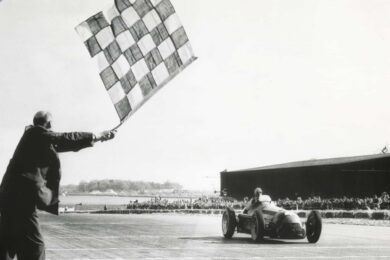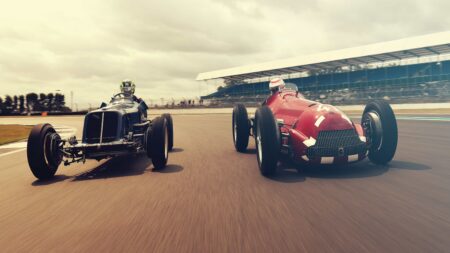The three rivals for 1950 F1 glory – the three Fs – represent a fascinating triptych in terms of racing character. Fangio was all grace and guile – and astonishing speed. He was a fitter by background, and his mechanical sympathy for the fast but fragile F1 cars of the 1950s was unparalleled. His driving was not so much aggressive as assertive, each movement unruffled, each decision assured.
Fagioli, by contrast, was a man out of his time. One of only six drivers born in the 19th century to compete in the F1 world championship – the others being Philippe Étancelin (born in 1896), Arthur Legat (1898), Clemente Biondetti (1898 also), Adolf Brudes (1899), and Louis Chiron (1899 also) – he adhered more to the devil-may-care disposition of the 1920s and 1930s than to the battle-toughened post-World War II ethos. He was nicknamed the Abruzzi Robber. His temperament was volatile. He clashed with team managers and team-mates alike. Yet he was fast as well as furious. A determined and dogged man, he was proof that age need not wither speed, nor experience subdue ferocity.
Then there was Farina, the strangest of the three. Possessing a doctorate in political science and the courtly mien of the aristocracy into which he had been born, he carried himself with a patrician detachment. His suits were flawlessly tailored, his hair immaculately pomaded. But put him in a racing car, and something changed. He drove, always, on the edge of violence – yet, paradoxically I have always thought, he was also the smoothest of stylists. His lines were geometric, his inputs measured, his methodology considered and refined. Indeed, he wrote about racing with the same analytical precision that he had brought to his academic studies. But although his technique was dexterous, his intent was savage. He would chop thuggishly across his opponents, and he would barge and bully his way onto the inside line even if by rights it belonged to someone else. At Deauville in 1936 he shoved Marcel Lehoux off the track – to his death. In 1938, at Tripoli, he did the same thing to László Hartmann, even though he had been lapping the poor man rather than racing him. The contradiction between Farina’s off-track politesse and his on-track hooliganism was not only a flaw but also an essence: he was both surgeon and soldier.

Chasing Villoresi at the 1938 Coppa Acerbo in Pescara
Robert Fellowes/LAT Images
He would sometimes light a cigar on a race’s cool-down lap, then coast to a stop as though he were parking outside a trattoria in Turin. He was an enthusiastic and successful womaniser. But, withal, he was also a man of bewildering contradictions. He could be delightful company – but, as reported by my friend Nigel Roebuck in the August 2003 edition of Motor Sport, Stirling Moss said of him: “Undoubtedly, Farina was a great driver, and I loved his relaxed arms-outstretched style. In fact I copied it. But on the track he was a bastard. If he was lapping you, you had to be damn’ sure not to hold him up – because, if you did, he’d just push you off the road.”
Here is an equally striking quote about him, from Fangio, translated from the Spanish: “Farina drove like a madman. We used to say that he was protected by the Virgin Mary, but even the Holy Madonna’s patience has a limit, and he should have considered that she couldn’t be at his disposal all the time.” And here is what Enzo Ferrari had to say, translated from the Italian: “Farina was a man of steel, inside and out, capable of crazy things, and a regular inmate of hospital wards as a result.”









